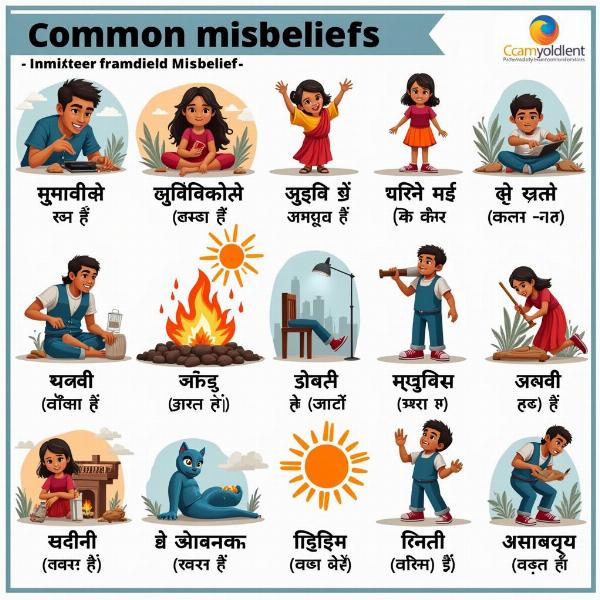Misbelief meaning in Hindi encompasses various terms depending on the nuance and context. Understanding the different ways to express “misbelief” in Hindi can enrich your comprehension of the language and culture. Whether you are translating documents, having a casual conversation, or studying Hindi literature, knowing how to convey this concept accurately is essential. This article explores the various translations of “misbelief” in Hindi, their connotations, and their usage in different scenarios.
Exploring the Hindi Translations of “Misbelief”
Several Hindi words can convey the meaning of “misbelief.” The most common translations include:
- भ्रांति (bhranti): This term signifies a delusion, illusion, or misconception. It often implies a false belief arising from ignorance or misunderstanding.
- गलतफ़हमी (galatfahmi): This word denotes a misunderstanding or misapprehension. It often refers to a mistaken interpretation of information or a situation.
- मिथ्या (mithya): This term signifies falsehood, untruth, or fallacy. It emphasizes the incorrectness of the belief.
- अंधविश्वास (andhvishwas): This word specifically refers to superstition or blind faith, often implying irrational beliefs based on fear or tradition.
The Nuances of Misbelief in Hindi
Each of these Hindi words carries slightly different connotations, making it crucial to choose the right word based on the specific context. For instance, using “भ्रांति (bhranti)” suggests a more profound misunderstanding than using “गलतफ़हमी (galatfahmi).” Similarly, using “अंधविश्वास (andhvishwas)” implies a belief rooted in superstition, whereas “मिथ्या (mithya)” simply points to the falsehood of the belief.
Misbelief in Indian Culture and Religion
Misbeliefs play a significant role in Indian culture and religion. Many traditional practices and beliefs are based on interpretations of ancient texts and oral traditions, sometimes leading to misconceptions or differing interpretations. Understanding the cultural context of misbeliefs is essential for navigating intercultural communication and avoiding misunderstandings.
Why is Understanding “Misbelief Meaning in Hindi” Important?
Knowing the different ways to express “misbelief” in Hindi can enhance your communication and understanding of Indian culture. Whether you are a student of Hindi, a business professional, or simply interested in Indian culture, this knowledge can be invaluable. It allows for more precise and nuanced communication, avoiding potential misinterpretations.
Common Misbeliefs and their Hindi Equivalents
Let’s consider some common misbeliefs and their Hindi equivalents:
- Misbelief: Black cats are bad luck. Hindi: काली बिल्ली अशुभ होती है (kali billi ashubh hoti hai) – This could be considered an अंधविश्वास (andhvishwas).
- Misbelief: Breaking a mirror brings seven years of bad luck. Hindi: शीशा तोड़ने से सात साल की बदकिस्मती आती है (sheesha todne se saat saal ki badkismati aati hai) – This is also an अंधविश्वास (andhvishwas).
- Misbelief: The earth is flat. Hindi: पृथ्वी चपटी है (prithvi chapti hai) – This would be a भ्रांति (bhranti).
 Common Misbeliefs in Hindi
Common Misbeliefs in Hindi
Conclusion
Understanding “misbelief meaning in Hindi” requires going beyond a simple translation. It involves grasping the nuances of different Hindi words and their cultural connotations. This knowledge is crucial for effective communication, accurate translation, and a deeper understanding of Indian culture and traditions. By exploring the various terms like भ्रांति (bhranti), गलतफ़हमी (galatfahmi), मिथ्या (mithya), and अंधविश्वास (andhvishwas), we can gain a more comprehensive understanding of the concept of “misbelief” in the Hindi language.
FAQ
- What is the most common Hindi word for “misbelief”? While several words exist, भ्रांति (bhranti) is often used to represent a general misconception.
- What is the difference between भ्रांति and गलतफ़हमी? भ्रांति implies a deeper misconception, while गलतफ़हमी often refers to a simple misunderstanding.
- How does अंधविश्वास differ from other terms for “misbelief”? अंधविश्वास specifically refers to superstitions.
- Why is it important to understand the cultural context of misbeliefs? Cultural context is crucial for avoiding misunderstandings and navigating intercultural communication effectively.
- Where can I learn more about Hindi translations? Meaning-Hindi.in offers expert translation services for various needs.
Meaning-Hindi.in is your premier resource for professional Hindi translation services. We specialize in business, legal, technical, website localization, educational, and specialized translations, offering quick turnaround times and expert linguistic support. Our team understands the nuances of both Hindi and other languages, ensuring accurate and culturally sensitive translations for all your needs. Contact us today for a free quote! Email: [email protected], Phone: +91 11-4502-7584. Let Meaning-Hindi.in bridge the language gap for you.